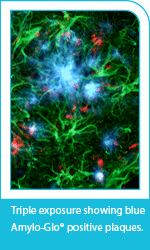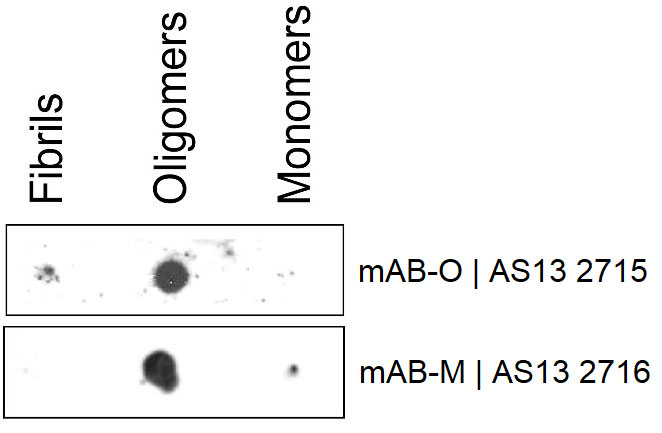Amyloid Beta Research

Amylo-Glo - Amyloid beta plaque staining
Amylo-Glo RTD is an excellent marker that shows clear superiority for visualising amyloid plaques over conventional markers. Its unique emission/excitation profile, high brightness and mild conditions make it suitable for multi-labelling and low magnification studies on tissues and cytochemistry.
It is also available with an EtBr counter stain allowing the assessment of amyloid plaques and cell/tissue positioning in one step.
To find out more please follow the link above
NS Blog: Amyloid beta plaque staining
|
||
|
More information is available on the links above or complete the form at the bottom of the page to request copies of the datasheets.
Our Biosensis MOAB-2 antibody (M-1586-100) is a new pan-specific monoclonal antibody to Amyloid beta residues 1-4 and provides unparalleled staining clarity, stronger reactivity and greater sensitivity than any other Abeta monoclonal antibodies previously available for research. Also, unlike other monoclonals such as 6E10 and 4G8, MOAB-2 does not cross react with APP or APP C-terminal fragments.
Biosensis' formulation of MOAB-2 is also the only one endorsed by the original developers.
Photo courtesy of Dr. Mary Jo LaDu and Dr. Leon Tai from the University of Illinois Chicago, Chicago, IL.
IHC staining of MOAB-2 on 2,4 and 6 month old 5XFAD mouse hippocampal sections showing increasing Aβ staining with MOAB-2 (Red); NeuN staining (Green).
More information is available on the links above or complete the form at the bottom of the page to request copies of the datasheets.
StressMarq Amyloid Antibodies
StressMarq offers two polyclonal antibodies to amyloid oligomers (A11), SPC-506 and Amyloid fibrils (OC), SPC-507 suitable for IHC, WB, ICC/IF and IP.
Amyloid fibrils (OC) antibody SPC-507 detects generic epitopes common to many amyloid fibrils and fibrillar oligomers but not prefibrillar oligomers or natively folded proteins. Also, SPC-507 shows no amyloid precursor protein (APP) cross-reactivity when compared with 6E10 by immunohistochemistry on Alzheimer’s Disease brain tissue.
Amyloid oligomers (A11) antibody recognises all types of amyloid oligomers and appears to recognise a peptide backbone epitope that is common to amyloid oligomers, but that is not found in native proteins, amyloidogenic monomer or mature amyloid fibrils.
Above: A – Anti-amyloid beta fibrils (SPC-507) – Human Alzheimer’s Disease Brain Plaque B – Anti- amyloid beta oligomers (SPC-506) – Human Alzheimer’s Disease Brain Plaque C – Composite - Human Alzheimer’s Disease Brain Plaque
More information is available on the links above or complete the form at the bottom of the page to request copies of the datasheets.
Agrisera Oligomer Specific Amyloid Beta Antibodies
Using a novel technique based on a combination of cryptic epitope and avidity to produce oligomer specific monoclonal antibodies[1], Agrisera offers two antibodies to the amyloid beta peptide, mAB-O (AS13 2715) and mAB-M (AS13 2716) that do no cross react with amyloid beta fibrils. Both antibodies have been developed in mouse and are of IgG isotype.
[1] Brännström et al. (2014). A Generic Method for Design of Oligomer-Specific Antibodies. PLoS ONE. DOI: 10.1371/journal.pone.0090857.
|
||







